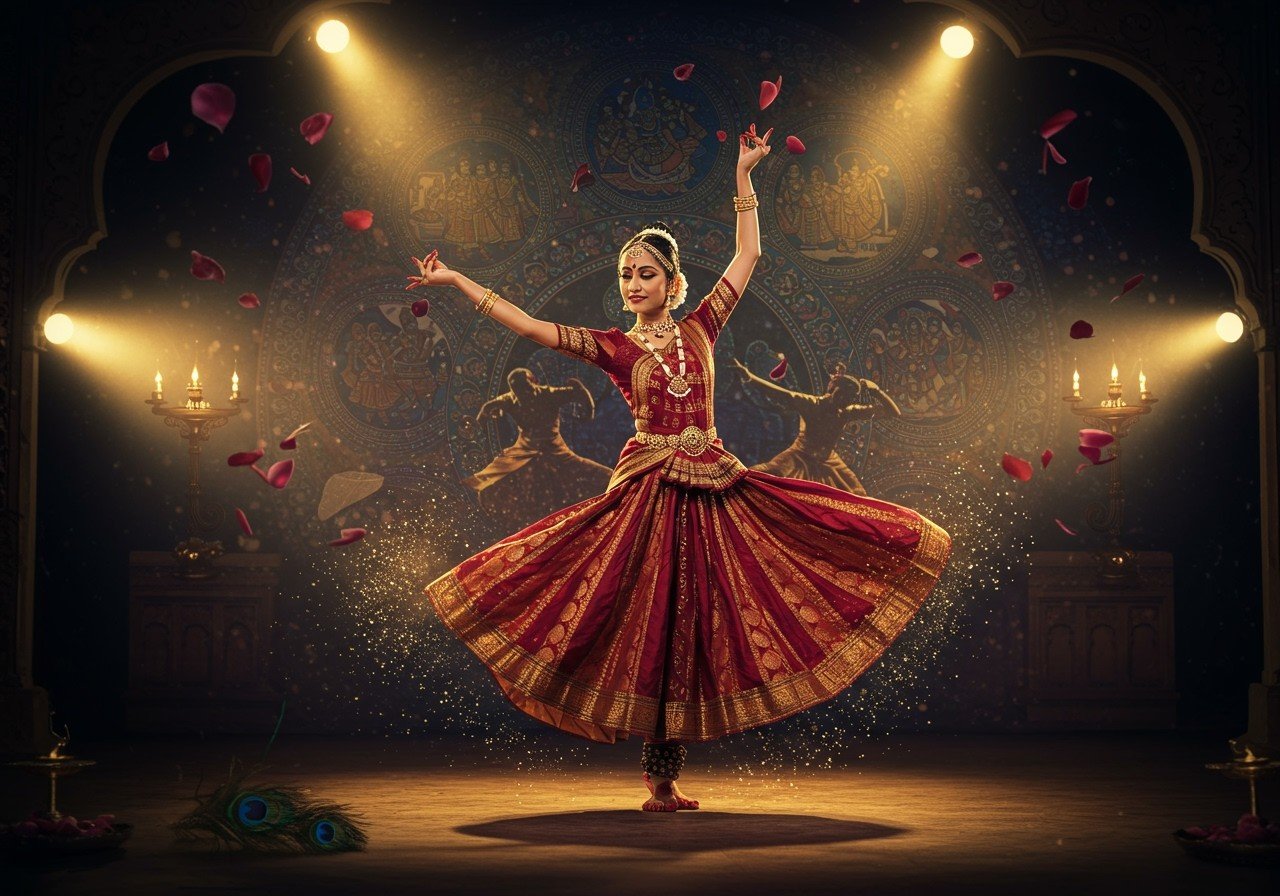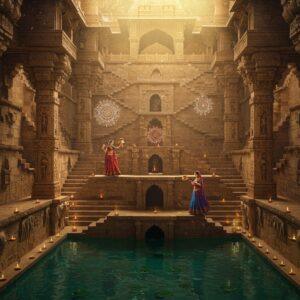
Kathak is a mesmerizing Indian classical dance form renowned for its captivating storytelling, rhythmic precision, and intricate footwork. Originating in Uttar Pradesh, India, Kathak beautifully interweaves Hindu and Muslim cultural influences. For those who appreciate tradition and seek authentic cultural experiences, exploring Kathak is a journey into the heart of India’s artistic heritage.
Origins and Historical Evolution
Kathak’s roots trace back to ancient northern India, where traveling bards, known as Kathakars, narrated tales from Hindu epics like the Mahabharata and Ramayana. These storytellers used a combination of dance, music, and song to bring these ancient narratives to life. Early references to Kathak’s dance and storytelling traditions appear in texts like the Adi Parva of the Mahabharata, Mauryan period inscriptions (4th–3rd century BCE), and the 13th-century treatise Sangeet Ratnakara.
Early Traditions and the Bhakti Movement
The name “Kathak” originates from the Sanskrit words “katha” (story) and “kathakar” (storyteller). These early Kathakars journeyed throughout the land, disseminating stories through their expressive art form. During the 15th-century Bhakti movement, a period of profound religious devotion centered on the Hindu god Krishna, Kathak embraced devotional themes. Varanasi, a sacred city, became a prominent hub for Kathak, where dancers depicted Krishna’s divine love and interactions with the gopis (milkmaids). This era imbued Kathak with spiritual depth, portraying the immortal love between Radha, Krishna, and the milkmaids with grace and devotion.
Want to learn more about the Ramayana? Check out these resources: Who Wrote the Ramayana? and Valmiki Ramayana: Author, Poet, Sage.
Mughal Era Influence
The 16th century marked a significant transformation for Kathak under Mughal patronage. The royal courts of Lucknow and Jaipur embraced this captivating dance form, introducing Persian and Islamic influences that enriched its music, aesthetics, and choreography. Kathak evolved into a sophisticated form of entertainment, emphasizing graceful, expressive, and sensuous movements. The incorporation of Urdu Ghazals and instruments from the Mughal period further distinguished Kathak, making it the only Indian classical dance form with Persian elements.
The Rise of Gharanas (Schools)
Today, two main branches, or gharanas, of Kathak prevail: Jaipur and Lucknow. The Lucknow gharana traces its lineage to Ishwari, a devoted follower of Krishna, who developed Kathak as an expression of devotion. The Jaipur style flourished under the patronage of the Rajput rulers of Rajasthan, retaining a strong religious character. The existence of both Hindu and Muslim gharanas highlights Kathak’s unique ability to bridge diverse cultural traditions.
Explore the history of Hinduism: Hinduism: A Complete History and Origin.
Kathak Today: A Living Tradition
Kathak continues to flourish as a vibrant and cherished art form. Its intricate footwork, expressive gestures, and narrative power resonate with audiences worldwide. From grand stages to intimate settings, Kathak performances connect the past with the present, celebrating India’s rich cultural heritage and the timeless beauty of storytelling through dance.
Enhance Your Kathak Experience with Poojn.in
Immerse yourself in the world of Kathak with authentic products from Poojn.in, India’s leading store for cultural goods and services. We offer a curated selection of items to enhance your Kathak journey:
- Pure Brass Ghungroo Sets: Elevate your performance with traditional ankle bells available in various sizes. Our ghungroos are crafted with high-quality brass for a rich, resonant sound.
Experience the authentic sounds of tradition with our carefully crafted sets. - Cotton Dance Practice Sarees: Practice with comfort and elegance in our lightweight, solid-colored cotton sarees. Designed for ease of movement, these sarees will allow you to focus on perfecting your art.
Move freely and gracefully during practice with our comfortable, flowing sarees. - Brass Puja Thalis: Begin your practice or performance with reverence using our beautifully crafted brass puja thalis for offerings and prayers. These thalis add a touch of tradition to your sacred rituals. Prepare for your dance with a moment of reflection using our intricately designed thalis.
- Pure Cotton Wicks, Copper Water Vessels, Organic Kumkum, Natural Camphor: Complete your Kathak rituals with essential items like pure cotton wicks for traditional oil lamps, copper water vessels for blessed water, organic kumkum for tilak application, and natural camphor for prayer ceremonies. All these items are available for convenient home delivery across India, ensuring you have everything you need for your Kathak practice.
Shop now at Poojn.in for all your Kathak and puja needs. We offer quality assurance, proper packaging, and year-round stock availability. Our customer service team is ready to assist you with your order.
Frequently Asked Questions about Kathak
What is Kathak? Kathak, a classical Indian dance form, is characterized by intricate footwork, expressive gestures, and captivating storytelling. It originated in northern India, particularly Uttar Pradesh, and evolved under the influence of both Hindu and Muslim traditions.
Where did Kathak originate? Kathak’s origins are in Uttar Pradesh, India. It evolved from the storytelling traditions of traveling bards known as Kathakars, who narrated epic tales and mythological stories through dance, music, and song.
How does Kathak tell a story? Kathak dancers are skilled storytellers, using expressive hand gestures (mudras), nuanced facial expressions, and rhythmic footwork to convey emotions and narrate stories from Indian epics, mythology, and folklore.
What distinguishes Kathak from other Indian classical dances? Kathak’s emphasis on storytelling, intricate footwork, and rapid spins sets it apart. Its blend of Hindu and Persian influences, particularly noticeable in the music and aesthetics, makes it unique among Indian classical dance forms.
Who can learn Kathak? Kathak is open to anyone with a passion for dance and storytelling, regardless of age or background. Beginners can start with foundational steps and progress to advanced levels with dedicated practice.
What is the cultural significance of Kathak? Kathak plays a vital role in preserving ancient storytelling traditions, connecting people with Indian history, mythology, and cultural heritage. It is a celebrated art form that showcases India’s rich and diverse artistic expressions.
How is Kathak performed today? Contemporary Kathak performances often blend traditional elements with modern themes, appealing to diverse audiences. Kathak dancers grace stages at festivals, cultural events, and even in films, ensuring this timeless art form continues to evolve and thrive.


